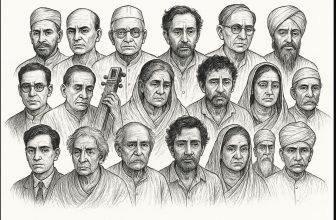India’s journey after independence has been marked by wars and conflicts that shaped its defense strategies, international relations, and internal security. While most people are aware of the major wars, several lesser-known aspects of these battles have had profound and long-lasting effects on the country’s military and strategic planning.
Post-Independence Battles That Shaped India’s History:
1. The First Kashmir War (1947-48): The War That Created the Kashmir Conflict
- Soon after independence, Pakistan-backed tribal forces invaded Kashmir.
- The Maharaja of Jammu & Kashmir sought India’s help, leading to Kashmir’s accession to India.
- Indian forces launched a counterattack, but the war ended with a ceasefire brokered by the United Nations.
Impact:
- The war led to the establishment of the Line of Control (LoC), which remains a major flashpoint to this day.
- It was the first time India engaged in modern warfare with tanks and air support.
- The conflict forced India to develop its intelligence and counter-insurgency capabilities, which were minimal at the time.
2. The 1962 Sino-Indian War: A Wake-Up Call for India’s Defense
- China launched a surprise attack over border disputes in Aksai Chin and Arunachal Pradesh.
- The Indian Army, under-equipped and poorly prepared, suffered heavy losses.
- China unilaterally declared a ceasefire and retained control over Aksai Chin.
Impact:
- Exposed India’s defense vulnerabilities, leading to major military reforms and increased defense spending.
- India started building border roads and airstrips in the Himalayas, which were neglected before the war.
- Created long-lasting suspicion in India’s foreign policy towards China, shaping future diplomatic and military strategies.
3. The 1965 Indo-Pakistani War: The Largest Tank Battle Since World War II
- Pakistan initiated Operation Gibraltar, sending infiltrators into Kashmir to incite rebellion.
- The war escalated into full-scale battles, including one of the biggest tank battles in history in Punjab.
- A ceasefire was declared after the Tashkent Agreement, brokered by the Soviet Union.
Impact:
- India realized the need for self-reliance in defense production, leading to increased domestic arms manufacturing.
- The war tested India’s Air Force strength, proving air power as a crucial element in warfare.
- Strengthened diplomatic ties with the Soviet Union, setting the stage for future cooperation.
4. The 1971 Indo-Pakistani War: The War That Redefined South Asia
- India supported the Bangladesh Liberation Movement against Pakistan’s military rule in East Pakistan.
- Pakistan’s attack on Indian air bases triggered India’s full-fledged military intervention.
- The war ended in just 13 days, leading to Pakistan’s surrender and the creation of Bangladesh.
Impact:
- Marked India’s first strategic use of a naval blockade, cutting off supplies to Pakistani forces in East Pakistan.
- Exposed Pakistan’s nuclear ambitions, prompting India to accelerate its own nuclear program.
- Created a permanent shift in South Asia’s power balance, making India the dominant regional power.
5. The Kargil War (1999): India’s High-Altitude Warfare Mastery
- Pakistani soldiers and militants infiltrated Indian positions in Kargil.
- India launched Operation Vijay to reclaim lost territory.
- After months of intense fighting, India recaptured most of the peaks by July 1999.
Impact:
- Exposed Pakistan’s reliance on irregular warfare, leading to India’s enhanced counter-insurgency measures.
- India developed satellite surveillance capabilities after intelligence failures were exposed.
- Strengthened India’s defense partnership with Israel, which provided crucial weaponry and technology.
6. The Siachen Conflict (1984-Present): The World’s Highest Battlefield
- In Operation Meghdoot, India preemptively occupied the Siachen Glacier, denying Pakistan control over the region.
- The conflict has continued as the longest-running military standoff at extreme altitudes.
Impact:
- Led to the development of specialized high-altitude warfare techniques, now used worldwide.
- The Indian Army became one of the most experienced forces in extreme cold-weather combat.
- Strengthened India’s control over glacial water sources, which are critical for river systems in North India.
7. The Doklam Standoff (2017): A Silent Victory for India
- China attempted to build a road in Doklam, a region claimed by Bhutan but strategically important to India.
- Indian forces intervened, leading to a 72-day standoff.
- China eventually backed down after diplomatic negotiations.
Impact:
- Increased India’s military cooperation with Bhutan, reinforcing regional alliances.
- Led to faster road-building projects along the Indo-China border to prevent future incursions.
- Marked India’s shift towards a more assertive border policy against China.
8. The Galwan Valley Clash (2020): The Bloodiest India-China Skirmish in Decades
- Tensions along the Line of Actual Control (LAC) in Ladakh escalated into a deadly hand-to-hand combat.
- Indian soldiers lost their lives, and China also suffered casualties (exact numbers undisclosed).
Impact:
- India imposed economic restrictions on China, banning 200+ Chinese apps, including TikTok and PUBG.
- Strengthened India’s border defenses, leading to increased troop deployment and infrastructure development.
- Shifted India’s foreign policy towards stronger Indo-Pacific alliances, including deeper cooperation with the Quad (India, USA, Japan, Australia).
Summary: Wars That Reshaped India’s Future
Each of these conflicts left a deep imprint on India’s military, diplomatic, and economic strategies. From the first war in Kashmir to the recent clashes with China, India has continuously adapted and evolved.
Some of the most critical, yet lesser-known impacts of these wars include:
- India’s rise as a self-sufficient defense power with indigenous arms manufacturing.
- Strategic border infrastructure development, preventing further incursions.
- Strengthening ties with international allies, enhancing India’s global influence.
- The shift from reactive defense to proactive military strategies, securing national interests.
These wars were not just battles fought on land, but turning points that shaped India’s standing in the world. Understanding these hidden impacts helps us appreciate the resilience, strategy, and foresight that define India’s military history today.





